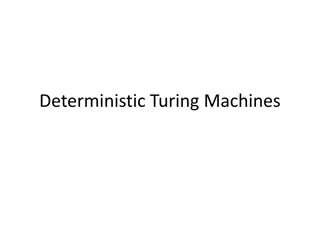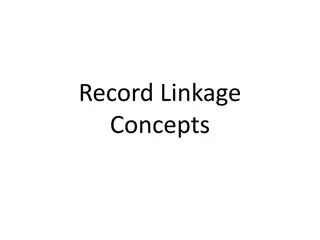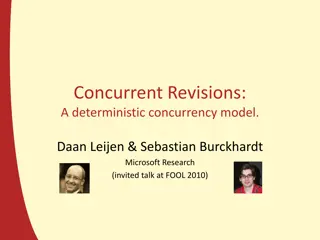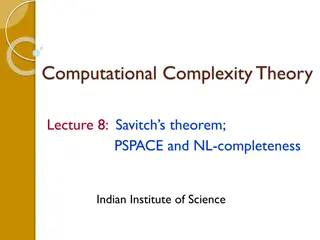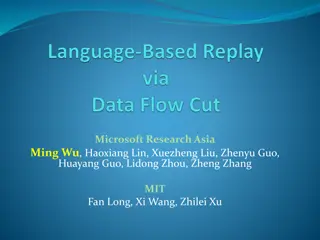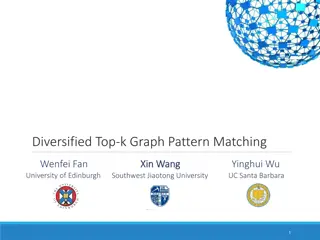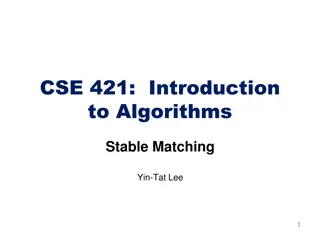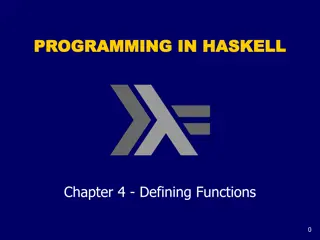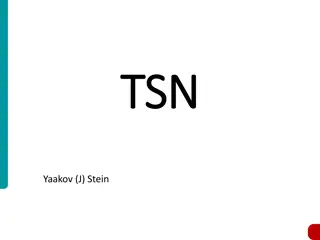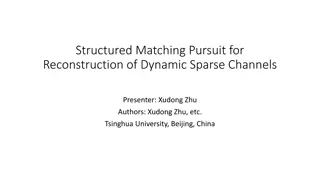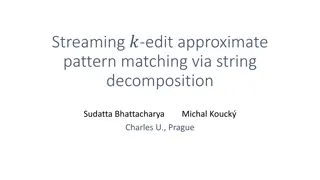Approaches in Studying Human-Environment Relationship
Explore different approaches to understanding the dynamic relationship between humans and their environment, including deterministic, teleological, possibilistic, and economic deterministic perspectives. These approaches shed light on how human actions and interactions with the environment have evol
8 views • 9 slides
Pushdown Automata and Language Acceptance
Pushdown Automata (PDA) provide a theoretical framework for recognizing context-free languages. In PDA, the acceptance of a language depends on reaching a final state or having an empty stack. This concept is illustrated through examples and the distinction between deterministic and non-deterministi
5 views • 10 slides
Deterministic Turing Machines
Detailed explanation of Deterministic Turing Machines, their constituents, formal definition, determinism, and special statuses such as Start, Accept, Reject, and Loop. Includes visual representations and key concepts of deterministic Turing machines.
2 views • 14 slides
Record Linkage Concepts
Explore the fundamentals of record linkage, also known as matching or merging, which involves combining data from different sources for the same individual. Learn about the importance of efficient and accurate duplicate detection, deterministic matching, and the challenges of variations in data betw
5 views • 20 slides
Concurrent Revisions: A Deterministic Concurrency Model
Exploring a deterministic concurrency model proposed by Daan Leijen and Sebastian Burckhardt, focusing on concurrent programming, threads, locks, futures, promises, transactions, and the resolution of conflicts in parallel performance.
0 views • 36 slides
Overview of Computational Complexity Theory: Savitch's Theorem, PSPACE, and NL-Completeness
This lecture delves into Savitch's theorem, the complexity classes PSPACE and NL, and their completeness. It explores the relationship between time and space complexity, configuration graphs of Turing machines, and how non-deterministic space relates to deterministic time. The concept of configurati
2 views • 67 slides
Enhancing Matching Gift Strategies for Nonprofits
Explore a comprehensive roadmap for maximizing matching gift opportunities provided by Double the Donation. This presentation covers important steps such as determining donor information, evaluating revenue, and setting timelines for success. Learn how to identify responsible departments and individ
2 views • 10 slides
Enhancing Replay Interface Efficiency in System Debugging
Efforts by researchers at Microsoft Research Asia and MIT focus on enhancing replay interface efficiency for system debugging. The motivation stems from the non-determinism challenges caused by time, user input, network I/O, and thread interleaving. The study observes that only certain parts of a pr
3 views • 26 slides
Graph Pattern Matching Challenges and Solutions
Graph pattern matching in social networks presents challenges such as costly queries, excessive results, and query focus issues. The complexity of top-k and diversified pattern matching problems requires heuristic algorithms for efficient solutions. Finding best candidates for project roles involves
3 views • 19 slides
Matching Keys in Database Systems
Matching keys play a crucial role in identifying the same real-world entities in database systems. They specify which attributes to compare and how to compare them, helping minimize redundancy and improve data accuracy. This summary discusses relative candidate keys, minimal matching keys, and relia
3 views • 13 slides
Stable Matching Problem and Gale-Shapley Algorithm Overview
The content provides information on the stable matching problem and the Gale-Shapley algorithm. It covers the definition of stable matching, the workings of the Gale-Shapley algorithm, tips for algorithm implementation, and common questions related to the topic. The content also includes a summary o
4 views • 16 slides
Cross-Device Tracking for Better Engagement
Delve into the world of cross-device tracking with insights on probabilistic vs. deterministic matching models, limitations of third-party cookies, reasons to engage in cross-device tracking, and the distinctions between probabilistic and deterministic matching methods. Explore how tracking across m
2 views • 41 slides
Stable Matching and Orderly Markets in Various Allocation Systems
Exploring the concept of stable matching and orderly markets in different allocation systems such as medical residencies, law clerk placements, and college admissions. From theory to practice, the history of the National Residency Matching Program (NRMP) to centralized clearinghouses, the importance
4 views • 36 slides
Pattern Matching: Overview and Applications in Technology
In the study of pattern matching, text and patterns are analyzed to locate specific patterns within text data. This process involves various algorithms like Brute Force, Knuth-Morris-Pratt, and Boyer-Moore. The applications of pattern matching span across different fields such as text editing, web s
0 views • 59 slides
Conditional Expressions and Pattern Matching
In Haskell programming, functions can be defined using conditional expressions, guarded equations, and pattern matching. Conditional expressions allow for defining functions based on conditions, while guarded equations provide an alternative approach to conditionals. Pattern matching offers a clear
4 views • 22 slides
Ultimatch: Matching Counterfactuals in Your Way
Ultimatch by Thorsten Doherr explores the concept of matching counterfactuals in a customizable manner, utilizing methods such as score-based matching, distance-based matching, and the Hypersphere-Leeway Algorithm. The tool allows for precise matching on observables and offers options for various ty
2 views • 10 slides
IEEE 802.11-17/1428r1 Deterministic Backoff Rules
This document discusses the deterministic backoff rules for IEEE 802.11-17/1428r1 protocol. It covers scenarios where fewer than three consecutive collisions occur and outlines the specific backoff algorithm to be followed. The document includes simulations and analysis pertaining to deterministic b
3 views • 19 slides
Fast Exact Matching Algorithms for Large DNA and Protein Sequences
Searching for specific sequences like "ssi" in "mississippi" can be efficiently done using algorithms like Suffix Trees and Boyer-Moore. These algorithms provide fast searching with low space cost, making them ideal for handling large DNA and protein sequences. While traditional algorithms like Knut
2 views • 40 slides
Time-Sensitive Networking (TSN) and Deterministic Networking
Time-Sensitive Networking (TSN) and Deterministic Networking (DetNet) technologies enable low-latency, guaranteed packet propagation, time-aware scheduling, high reliability, and seamless redundancy for critical applications in various sectors such as industrial automation, communication systems, an
2 views • 41 slides
Maximizing Happiness Through Ice-Cream Matching Problem
The Ice-Cream Matching Problem involves finding a matching that maximizes the total happiness of children by assigning each child one serving of ice-cream in a different flavor based on their preferences. The problem is formulated as a linear programming model where decision variables represent the
2 views • 12 slides
Dynamic Sparse Channel Reconstruction through Matching Pursuit
Learn about the Structured Matching Pursuit method for reconstructing dynamic sparse channels efficiently utilizing compressive sensing algorithms such as Orthogonal Matching Pursuit (OMP) and Compressive Sampling Matching Pursuit (CoSaMP). Explore the system model, temporal correlation of dynamic c
0 views • 14 slides
Deterministic and Non-Deterministic Data in Mechanical Engineering
Explore the concepts of deterministic and non-deterministic data in the field of mechanical engineering. Learn how to classify data, differentiate between types of physical variables, and understand the implications for experimental methods. Get insights into the application of random signals in mec
3 views • 13 slides
Advanced Pattern Matching Techniques for Efficient Data Streaming
Explore the cutting-edge methods of pattern matching in data streaming, including approximate pattern matching and string decomposition, designed by experts in the field. Discover algorithms that optimize space and time efficiency while swiftly identifying patterns amidst data streams. Dive into the
1 views • 10 slides
Advanced Data Mining Techniques in Online Algorithms, Bipartite Matching, and Graph Matching
Explore advanced data mining concepts such as online algorithms, bipartite matching, and graph matching. Learn about different matching strategies, optimal solutions, and algorithms for bipartite graphs. Discover the process of online graph matching and its applications in real-world scenarios like
4 views • 28 slides
Deterministic Context-Free Languages
Discover the concept of Deterministic Context-Free Languages (DCFL) - a subset of context-free languages accepted by Deterministic Push-Down Automata. Learn about their properties, importance, and examples.
3 views • 13 slides
Detecting Assumptions on Deterministic Implementations of Non-deterministic Specifications
Explore the challenges of code assumptions in deterministic implementations of non-deterministic specifications. Learn about the potential risks of assuming deterministic behavior and how tools like NonDex can help in detecting and addressing such issues to improve code reliability.
0 views • 23 slides
Deterministic STS Field for Sensing in Wireless Personal Area Networks
This document introduces supercomplementary zero-sum cross-correlation code blocks for usage as a deterministic STS field in IEEE 802.15.4ab standard, aiming to promote the adoption of SZC code blocks. The submission emphasizes the properties and benefits of SZC code blocks and highlights their pote
4 views • 11 slides
Maximum Matching in Bipartite Graphs: Theory and Algorithms
Explore the concept of maximum matching in bipartite graphs, covering the definition, the maximum matching problem, theorems, and algorithms for finding augmenting paths. Understand how to construct a maximum matching in an undirected graph and learn about key strategies for optimizing matching solu
0 views • 34 slides
Graph Matching and Maximum Matching Problem Analysis
Explore the concepts of graph matching and the maximum matching problem in undirected graphs. Understand definitions like matching, augmenting path, and theorems related to maximum matching. Delve into proofs and strategies for constructing maximum matchings in graphs.
5 views • 21 slides
Achieving Deterministic Latency in JESD204B Link
Explore the challenges and solutions for achieving deterministic latency in JESD204B links by understanding latency concepts, tradeoffs, and design methods. Learn how to guarantee deterministic latency and optimize link performance.
3 views • 49 slides
Understanding String Matching with Regular Expressions
Explore the concept of string matching with regular expressions, including exact matching and regex matching. Learn about common regular expression patterns and examples. Discover how to create regex patterns for specific cases, such as emails and phone numbers.
1 views • 22 slides
Understanding Schema Matching Techniques and Challenges
Explore the world of schema matching, where concepts from one schema are matched with another to enable effective data mapping. Discover the complexities involved, such as schema heterogeneity and various matching approaches like constraint-based and linguistic matching. Uncover key issues like insu
0 views • 15 slides
Guaranteed Stable Matching with Propose-and-Reject Algorithm
Learn about the Propose-and-Reject Algorithm, an intuitive method introduced by Gale-Shapley in 1962, that guarantees finding a stable matching in the Stable Matching Problem. Understand the efficiency and implementation details for solving the stable matching problem, along with insights into diffe
3 views • 35 slides
Dependent Pattern Matching Semantics: Edinburgh Study Findings
Explore the coverage semantics for dependent pattern matching as researched by Joseph Eremondi and Ohad Kammar from the University of Edinburgh. The study delves into the intricacies of pattern matching, sheaves, and topologies, presenting a unique perspective on existing concepts. Discover the impl
2 views • 26 slides
Pseudo-Deterministic Proofs and Search Problems
Explore the concept of pseudo-deterministic algorithms in search problems, showcasing examples and subsequent research in the field. Delve into pseudo-deterministic interactive proofs and their implications for canonical answers with high probability.
0 views • 21 slides
Matching Approaches in Schema Integration
Discover the essence of constraint-based and learning-based matching approaches in schema integration. Explore how schema definitions, instance-based techniques, and structure-based approaches play crucial roles in determining the similarities between schemas for effective classification. Dive into
0 views • 15 slides
Uncovering Covert Timing Channels with Time-Deterministic Replay
Explore how to detect covert timing channels using time-deterministic replay to compare observed and expected timings, aiding in identifying both known and novel channels. Discover the challenges of predicting expected timings and how deterministic replay can help in reproducing timings for detectio
0 views • 26 slides
Stable Matching and Gale-Shapley Algorithm Example
Explore the concept of stable matching and the Gale-Shapley algorithm through an example instance. Understand the process of finding stable matches in two groups with preference lists using the Gale-Shapley Algorithm. Dive into the principles of perfect matching, stability, and unstable pairs in the
0 views • 43 slides
Parametrized Matching Algorithms
Discover the world of parametrized matching algorithms including Less Than Matching, Not Exact Matching, and Order-Preserving Matching. Explore the concepts and applications explained in detail.
0 views • 33 slides
Balancing Covariates in Epidemiology: The Role of Matching
Matching is a crucial preprocessing technique in epidemiological research, aiming to balance covariates between different study groups to facilitate valid comparisons and strengthen causal inference. Common support and balance are key factors in successful matching, with types such as individual-lev
0 views • 10 slides


